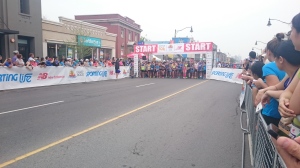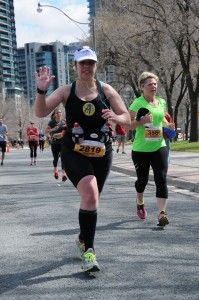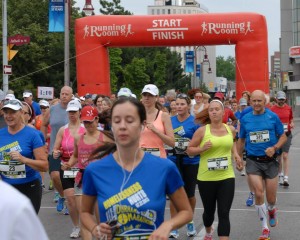On Sunday, I ran my first race of 2015. It was the Sporting Life 10K, a massive event that takes over 25,000 runners down Toronto’s iconic Yonge Street. I was just a little bit apprehensive going into the race, because my training has been somewhat sporadic of late. I have been doing my weekly long runs, but the shorter mid-week runs have been on-again/off-again. I have done a little bit of speed training, but no hill training whatsoever. As for strength training – well, that hasn’t even been a gleam in my eye.
Still, I thought this race would be fairly easy. My weekly long runs have had me doing distances longer than 10K, and I figured that since the Sporting Life 10K is basically a downhill run, my lack of hill training wouldn’t matter. The race did in fact start very well, and the first 5K went quite quickly. As soon as I ran over the halfway timing mats, though, the wheels started to fall off, and I ran the second half about three minutes slower than the first. I finished with an official time of 1:07:02, which is nowhere close to my best time. In fact, it’s probably one of my worst.
My spirits were somewhat lifted yesterday morning when I checked my race stats and saw that I still managed to come in just a fraction ahead of the middle of the pack. I was comfortably in the top 50% of women, and in my category – women aged 45-49 – I was in the top third. I’m not under any illusion that I actually did well – I’ve run this same course almost seven minutes faster – but these stats do tell me that race conditions were difficult on Sunday.
For a start, it was a lot hotter than I thought it was going to be. I have a feeling many people were caught off-guard by this. Everyone has been training in mild temperatures: being hit with blazing sun on race day would affect the performance of most runners. Then there was the fact that there were so many people. Even allowing for the fact that runners were released in corrals 15 minutes apart, there were still thousands of runners in each corral. During the early stages of the race, and to extent later on, I was doing a great deal of ducking and weaving to get past people who were slower than me. It took a lot of energy and it made it very difficult for me to find any kind of rhythm.
So maybe I did OK in light of the conditions.
But still… I have come to expect more of myself. I am intending to run a 2:15:00 half-marathon in October, and I will not do it with the half-baked efforts that I have been putting into my training. I am a runner. It’s time for me to start acting like one.
Sunday’s race woke me up to some things that I have to change. Immediately.
1. I have to step up my training. I am not going to become a better runner if I’m not consistent about it. Yes, life is very stressful right now and yes, time is a big issue for me. But for several years now, I have been very low on my own priority list. It’s time for me to devote more time to my health. All it takes is a couple of hours on Sundays and an hour on four other days each week. If I cannot manage to carve out six hours a week for exercise, then I’m just making excuses.
2. I have to resume my oatmeal breakfasts. I need to fix my eating habits in general, but I’m not expecting myself to accomplish that overnight. What I can do overnight, though, is bring back one simple routine that was healthy not only for me, but for the rest of my family.
3. I have to get more sleep. I have reached the point where six hours counts as “a good night’s sleep”, and I am experiencing permanent bone-crushing exhaustion.
4. I have to get a sports bra that fits properly. The chafing that I go through after every run is excruciating. The longer or harder the run, the worse the chafing. On Sunday afternoon, the feeling of clothing against my skin was making me cry.
5. I need to make a proper display of my bib numbers and finisher’s medals. Seeing the distances that I have run and the bling that I have earned will keep me motivated and remind me of what I am capable of.
6. I have to regroup, reset and make a new plan. For the last few weeks, I have been scrambling to train for a half-marathon on May 24th. This is a hard thing to admit, but people, I’m not going to do it. I could do it. I know that I have the physical ability, at my current level of fitness, to complete the distance. But it will be with a lot of pain and anxiety, and I wouldn’t enjoy it. As soon as I feel dread rather than excitement about an upcoming race, it’s time for me to bow out. And so I have transferred my registration to another race in the series, and I am plotting out a new training plan that will take me to a fabulous half-marathon in October.
As I contemplate the races that I have coming up, and the new plans that I am making, I can already feel the excitement building in my gut. I can feel that once again, I am going to run for the love of running.
This is an original post by Kirsten Doyle. Photo credit to the author.












